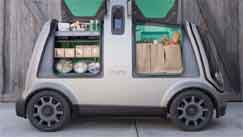The march towards autonomous vehicles – from ocean container ships to farm equipment - continues on. But, a new report from the Wall Street Journal says we are far more likely to see robot delivery vehicles than we are autonomous passenger cars any time soon.
"There are a number of reasons things are trending this way, including laws, physics, the nature of existing infrastructure, and the size of the addressable markets,” writes Christopher Mims. "But the chief reason, argue academics, analysts and the heads of autonomous-delivery startups, is safety. Protecting human passengers while avoiding accidents with other vehicles is much higher stakes than protecting a pint of ice cream or those headphones you just ordered.”
Supply Chain Digest Says... |
|
| All these companies and more could in the end dramatically both retail and consumer behavior. |
 |
What do you say? |
| Click here to send us your comments |
 |
| Click here to see reader feedback |
|
|
However, there are many challenges even for ecommerce deliveries, a market being targeted by companies such as Starship Technologies, which has developed a delivery vehicle that look more like a mobile robot on wheels than a van.
But many logistical hurdles remain. The largest may be that unless cities can create special lanes for these delivery bots, interaction with humans on city sidewalks can be an issue.
In fact, the Wall Street Journal article notes that the delivery vehicle built by a team led by Michael Chia-Liang Lin, a Ph.D. candidate at MIT, crashed right into a bunch or journalist covering the demonstration of the new technology in 2015. No one was hurt, and Lin now says the vehicles, in on-going tests in Taiwan, no longer run into people.
It was probably something of a fluke, but just last month, it was widely reported that a battery problems caused an autonomous, cooler-size delivery robot from a company called Kiwiboth to catch fire on the University of California, Berkeley campus, where the robots have been tested for the past two years.
Many startups are playing in this market, in addition to Starship Technologies.
In media event that also took place in December, a company called Nuro (which has a tag line of "Delivering the future of local commerce, autonomously”) held a media event showing its autonomous delivery vehicle designed to drive on the street.
The Nuro vehicle (see photo below) look sort of like half a delivery van, both in length and width, with multiple compartment options where it can store deliveries from a vase of flowers to a restaurant meal.
 The Nuro vehicle travels at a maximum speed of 25 miles per hour – and is programmed to sacrifice itself in the event of a looming crash with a person or a vehicle. The Nuro vehicle travels at a maximum speed of 25 miles per hour – and is programmed to sacrifice itself in the event of a looming crash with a person or a vehicle.
"By removing people you can do a lot more with the design of the vehicle in both hardware and software,” Dave Ferguson, who helped lead Alphabet company's Waymo self-driving car unit before co-founding Nuro in 2016, told the Wall Street Journal.
He cited, for example, the fact that without people engineers can design safety features on the outside of a vehicle instead of inside.
(See More Below)
|
CATEGORY SPONSOR: SOFTEON |
|
|
| |
|
|
Another interesting twist: if you design delivery vehicles that don't go more than 25 miles per hour, they qualify as "low speed vehicles” under federal and state standards, and thus can omit many at traditional safety features..
Then there is a company called Robomart, which says it has partnered with a yet-to-be- announced top-five grocery chain in the US for its low-speed vehicles made from foam and fiberglass that will simply collapse if it hits anything.
But it's not only about startups.
Beyond ABC's Waymo, for example, Toyota is developing its own autonomous delivery vehicle, called the e-Palette, while also investing in new companies such as Boxbot. Ford and GM are also developing autonomous delivery vehicles.
All these companies and more could in the end dramatically both retail and consumer behavior.
"With sufficiently inexpensive autonomous delivery services, we might stop going to the grocery store, or at least stop carrying our groceries home,” the Wall Street Journal's Mims notes. "We might buy things more often, rather than loading up our crossover SUVs with a week's worth of goods.
The real game changer might be if these new age robots can significantly reduce the cost of local deliveries.
Do you think we will see the delivery robots soon? Will they dramatically change consumer behavior? Let us know your thoughts at the Feedback section below.
Your Comments/Feedback
|